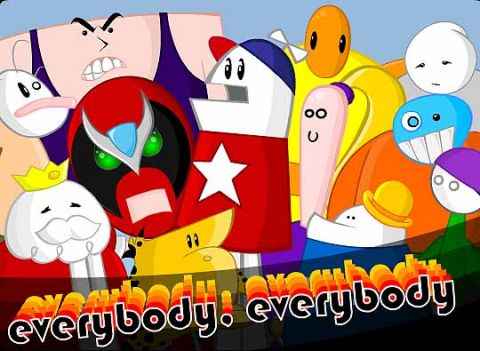
Back in the ’60s, Robert L. Short had a surprise bestseller with a book on The Gospel According to Peanuts. Short had a lot to work with in a strip like Peanuts, whose creator Charles Schulz was documentably preoccupied with spiritual matters. But finding the theology of Homestar Runner is another matter altogether. There isn’t one. I do hereby announce that there is no theology of Homestar Runner.
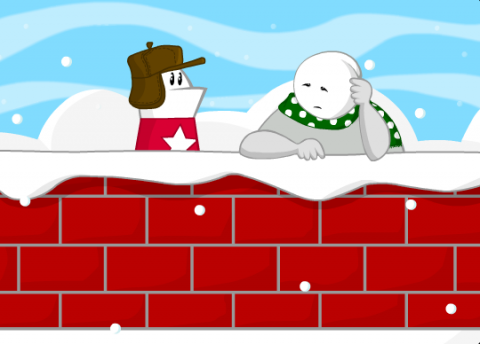 The contrast with Peanuts is so telling that I take it to be the best point of entry: Homestar Runner is some kind of digital Charlie Brown in the Secular Suburb. Like the Peanuts gang, Homestar characters wander around a minimalist landscape in a perpetual after-school zone, but in this case it’s a kind of Twilight of the Fhqwgads. How old are these kids, anyway? Are they kids at all? It’s a strange place where anything can happen, but one thing that can’t happen is any kind of inbreaking from beyond: there is no transcendence here, no open heaven. Where there ought to be an openness to the beyond, the world of Homestar is turned inward in a series of increasingly complex interior dialectics: self-referentiality, pop-culture allusiveness, a fugue of sub-creator loops, and spiraling ironies. The fugues and loops and ironies are not about something; they are the point. The world of Homestar, Free Country USA, is designed not so much to keep God out as to keep us from noticing he’s gone. In that regard, Homestar is a perfect reflection of the youth culture it’s simultaneously spoofing and feeding. If you want to see the postmodern coccoon that we weave around ourselves to keep things under control, here ’tis, made visible, entertaining, and even beguilingly cheerful.
The contrast with Peanuts is so telling that I take it to be the best point of entry: Homestar Runner is some kind of digital Charlie Brown in the Secular Suburb. Like the Peanuts gang, Homestar characters wander around a minimalist landscape in a perpetual after-school zone, but in this case it’s a kind of Twilight of the Fhqwgads. How old are these kids, anyway? Are they kids at all? It’s a strange place where anything can happen, but one thing that can’t happen is any kind of inbreaking from beyond: there is no transcendence here, no open heaven. Where there ought to be an openness to the beyond, the world of Homestar is turned inward in a series of increasingly complex interior dialectics: self-referentiality, pop-culture allusiveness, a fugue of sub-creator loops, and spiraling ironies. The fugues and loops and ironies are not about something; they are the point. The world of Homestar, Free Country USA, is designed not so much to keep God out as to keep us from noticing he’s gone. In that regard, Homestar is a perfect reflection of the youth culture it’s simultaneously spoofing and feeding. If you want to see the postmodern coccoon that we weave around ourselves to keep things under control, here ’tis, made visible, entertaining, and even beguilingly cheerful.
Lest you think I’m fabricating the comparison to Peanuts, note that it is invited by the cartoon itself: the episode called The Best Decemberween Ever is of course “sponsored by Dolly Madison” with Strongsad and Homestar conversing over a half-wall like Charlie Brown and Linus. The first Decemberween show is faux-copyrighted 1965 and has a theme song that’s sure to hit your nostalgia button.
Or it might not. I suppose Homestar could be enjoyed just for its absurdist pyrotechnics and playfulness. This cartoon is the very Apotheosis of the Random, and anybody who loves nonsense humor (I plead guilty) can find their fill here. But much of its muscle comes from the pop-culture fluency which it exhibits and evokes, and this is the first of Homestar’s diversionary tactics. 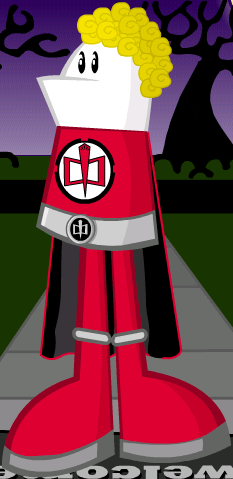 Whoever the target audience is, there must be some range of viewers who “survived the 80s” (as the Brothers Chaps say in an interview) and are perfectly primed for the shock of recognition when a ’til-now-forgotten cultural icon walks on stage. I blushingly admit to catching my breath when Homestar dressed up as The Greatest American Hero. There’s great fun in discovering that somebody else remembers that mediocre TV show you –no, we — grew up on. This must be the cheapest grade of nostalgia available anywhere: remembering TV together and being ushered into a community by scoring high enough on a pop-culture fluency exam. Still, it’s nice to feel not so alone in having wasted your youth watching dumb TV, playing bad video games, listening to music that’s now unlistenable for anything but flashback value.
Whoever the target audience is, there must be some range of viewers who “survived the 80s” (as the Brothers Chaps say in an interview) and are perfectly primed for the shock of recognition when a ’til-now-forgotten cultural icon walks on stage. I blushingly admit to catching my breath when Homestar dressed up as The Greatest American Hero. There’s great fun in discovering that somebody else remembers that mediocre TV show you –no, we — grew up on. This must be the cheapest grade of nostalgia available anywhere: remembering TV together and being ushered into a community by scoring high enough on a pop-culture fluency exam. Still, it’s nice to feel not so alone in having wasted your youth watching dumb TV, playing bad video games, listening to music that’s now unlistenable for anything but flashback value.
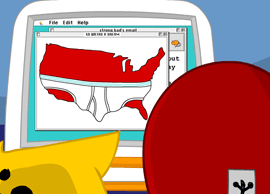 That may be the project in mind, but the result is that Homestar is pretty much a cartoon about cartoons and other entertainment ephemera. At times it’s just as much television about television as Beavis and Butthead or those cringeworthy VH1 shows ever were. Watching Homestar means watching the back of Strongbad’s head as he watches an old computer screen with all sorts of wacky stuff on it. Free Country USA (or Strongbadia, or wherever) might be a big place, but if you’re watching this cartoon you might as well admit you’re “Looking at a Thing in a Bag.”
That may be the project in mind, but the result is that Homestar is pretty much a cartoon about cartoons and other entertainment ephemera. At times it’s just as much television about television as Beavis and Butthead or those cringeworthy VH1 shows ever were. Watching Homestar means watching the back of Strongbad’s head as he watches an old computer screen with all sorts of wacky stuff on it. Free Country USA (or Strongbadia, or wherever) might be a big place, but if you’re watching this cartoon you might as well admit you’re “Looking at a Thing in a Bag.”
Homestar brings out one embarrassing memory after another and parades it around the website. No heavy metal band is too shrieky, no computer game too pixellated, and no TV show too worthless to be dredged up from the collective goo of our cultural swamp and spoofed at Homestar. 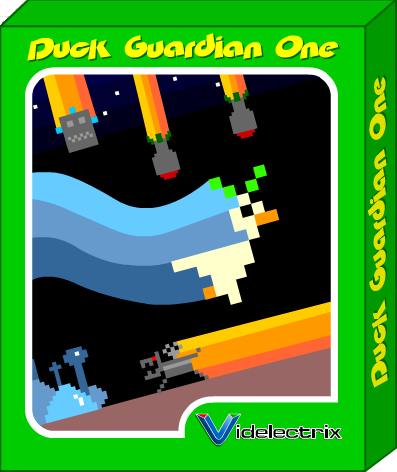 Obsolete technology is pervasive at Homestar, and is genuinely amusing. How could we ever have liked some of that stuff we gave our hours to?
Obsolete technology is pervasive at Homestar, and is genuinely amusing. How could we ever have liked some of that stuff we gave our hours to?
The easy thing to do would be to mock all that retro schlock from a position of superiority, but this is precisely where Homestar Runner refuses the easy option and instead takes another spin around the irony circuit. When it launched back in 2000, Homestar Runner had the advantage of being a new thing under the sun: it’s a flash animated web cartoon, with all past episodes always available for viewing at homestarrunner.com, and regular updates. It’s free and it displays no advertising. Flash animations feel a little like watching a cartoon and a little like playing a videogame. It’s a far cry from the old syndicated newspaper strip delivered to your doorstep in a roll of rotting newsprint: Schulz and his peers in print comics had to negotiate a sprawling set of editors, publishers, and distributors. The Brothers Chaps (even the name of the creators is disorienting at first), on the other hand, make a cartoon, click on “upload,” and their work is instantly available to the millions of viewers who come to the site every month. Power to the people, man! Gutenberg with a warp drive!
Is a flash-animated web comic The Next Big Thing for “a time when new media was the big idea,” or is it a gimmick that will only seem interesting until the tide of technology rises a bit higher and renders this medium quaintly dated? 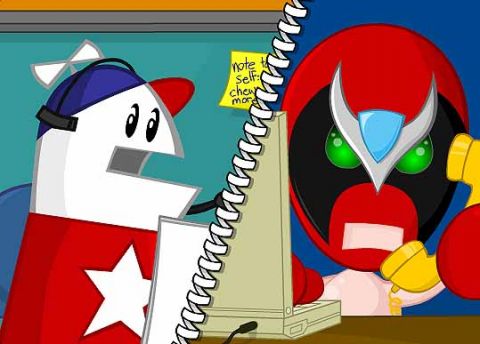 A question like this is not a side issue for Homestar Runner; it’s actually a good angle on what the whole enterprise is about. Homestar is an acutely self-conscious cartoon. It knows it’s in a gimmicky medium and that the inernet lives by hype. As Strongbad advises,
A question like this is not a side issue for Homestar Runner; it’s actually a good angle on what the whole enterprise is about. Homestar is an acutely self-conscious cartoon. It knows it’s in a gimmicky medium and that the inernet lives by hype. As Strongbad advises,
I’ve been around this great, big internet of ours a few times, so I know what I’m talking about, and I can safely say, that whatever idea you have is completely unimportant as long as you adhere to these fundamentals: First of all, you want to start out with a long flash intro.
Ah, the long flash intro. Like the spinning .gifs and the cursor-chasers of the Worst Websites Ever, these are brought in for mockery at Homestar. “We’ll make the covers of all the latest blogs,” enthuses one character, while a Teen Girl raves, “I wish the mall could be my ring tone!” The folks at Homestar seem well aware that with all their crazy go nuts skills with flash animation, they’re still nothing but tomorrow’s Tandy 400. 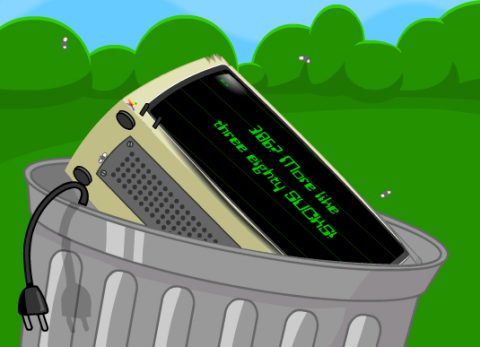 Obsolescence is a vengeful genie, and once it’s out of the bottle there’s no stopping it. Strongbad’s advice is: “The Internet is a place where absolutely nothing happens. You need to take advantage of that.”
Obsolescence is a vengeful genie, and once it’s out of the bottle there’s no stopping it. Strongbad’s advice is: “The Internet is a place where absolutely nothing happens. You need to take advantage of that.”
Homestar does take advantage of that. But again, where the easy way out would be to find some kind of deliverance in the free play of boundless creativity, the Brothers Chaps make it harder on themselves. The exit door marked “art and creativity” has been used by generations of desperate existentialists, but Homestar is made of sterner stuff. The folks at Homestar Runner look creativity in the face and mock it. They make it an issue just to show it cannot deliver on its promise.
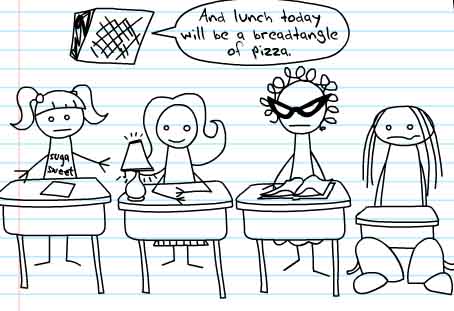 The proof of this is the way “The Homestar Universe” includes so many sub-universes created by main characters. Some of the best content at the site includes cartoons created by the main cartoon characters (Teen Girl Squad!). On one level, this is a giddy celebration of creativity: the Brothers Chaps are so creative that their creatures are creative.
The proof of this is the way “The Homestar Universe” includes so many sub-universes created by main characters. Some of the best content at the site includes cartoons created by the main cartoon characters (Teen Girl Squad!). On one level, this is a giddy celebration of creativity: the Brothers Chaps are so creative that their creatures are creative.
But there are two reasons to withhold a rosy interpretation of the sub-universes. First, it is sobering that the more evil a Homestar character, the more productive he is as a creator. The most evil character, Strongbad, is the one most likely to generate new things and characters at the drop of a hat, and the author of the popular Trogdor the Burninator and the consistently funny Teen Girl Squad. In second place, both for evil and creativity, is The Cheat (we are obliquely advised that he plays Leporello to Strongbad’s Don Giovanni), whose fertile mind generates a whole new version of Free Country USA called “Powered by the Cheat.” The relatively virtuous characters on the site don’t produce nearly as much as the bad guys do. Strongsad is creative too, but let us avert our eyes from that sorry art-school spectacle. The point is: Who’s Gonna Start a Rock and Roll Band? The bad guys, not the good.
The second worrisome element about creativity at Homestar is that the created sub-creators tend to hold their creations in utter contempt. Often, as with Teen Girl Squad, they are created out of spite, as a cheap joke which takes on a life of its own. Strongbad has such disdain for the Teen Girls that he can’t get Kirste/Kirsten/Kristina’s name right, he randomly assassinates his own creations (arrow’d!) in gruesome ways, and when he enters their sub-universe, all he can do is wonder what kind of burger places they have. Strongbad is kinder and gentler with Trogdor, but that’s because he’s using Trogdor to burninate the countryside, the peasants, and all their thatched roof cottages in a knock-off of sword-and-sorcery epics.
Strongbad’s standards for his creations are so low that when he produces something decent he expresses surprise. Looking at the first issue of Teen Girl Squad, he says “I should maybe make some crappy Xeroxes of that thing and sell it over at bubs. Or at least at some snooty independent record store.” In one of the many “easter eggs” hidden around the site, the viewer can click on the words “snooty independent record store” to get this inane dialogue between a store employee and a regular customer trying to out-cool each other about a band:
CLERK: I mean… I saw, I saw ’em… I saw ’em, like, twice… Actually, uhm, uh, last night, I saw them.
CUSTOMER: Yeah, I saw them… I saw them earlier this morning. Yeah.
CLERK: Oh.
CUSTOMER: Like, four times.
CLERK: Oh.
CUSTOMER: Yah. I mean I’ve been a big, I’ve been a bigger fan than you for a while, I mean…
CLERK: Yeah, well…
CUSTOMER: For a lot longer probably, too…
The only girl in the universe, Marzipan, is not evil and does have some musical creativity, but she is mainly used for the single joke “too earnest and ironic.” She is seen painting “Decemberween Kills Bunnies” signs (while brainstorming about what to buy Strongbad for the holiday), giving a free concert for birds, and using the screen name hooray4dolphins.
What we end up with is hardly a high view of art, but rather layers and layers of jaded creators crafting sub-creations, out of some evil impulse to create. Yikes! In fact, if Homestar Runner is a kind of latter-day Peanuts, it seems that somehow it’s a Peanuts in which Lucy has become the star. Strongbad would gladly pull the football out from in front of Charlie Brown or anybody else, and Strongbad is The Man in this universe. His brothers, Strongsad and Strongmad, form some Karamozovian unholy trinity of strong total depravity.
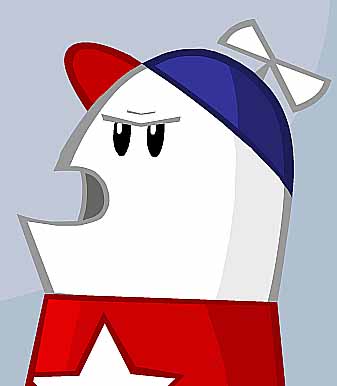 “If there is no God, everything is permitted,” warned Dostoyevsky through his characters. Strongbad got the instant message on his Tandy a long time ago, and is on to the next lesson: “Every time I look at myself, I can’t believe how awesome I am.” He leads the way in a tonedeafness to religion that is palpable at HomestarRunner.com. In a notorious scene, Strongbad sings a song for Decemberween, to the tune of O Holy Night:
“If there is no God, everything is permitted,” warned Dostoyevsky through his characters. Strongbad got the instant message on his Tandy a long time ago, and is on to the next lesson: “Every time I look at myself, I can’t believe how awesome I am.” He leads the way in a tonedeafness to religion that is palpable at HomestarRunner.com. In a notorious scene, Strongbad sings a song for Decemberween, to the tune of O Holy Night:
O holy crap
And something, something, something
Ah, there was this guy
And he was probably born
They didn’t know
If he was really stupid
But then they asked somebody
And they said he was stupid
At this, even Homestar’s jaw drops. It’s not clear what he thought should be done to commemmorate Decemberween, but obviously some standard has been violated when Strongbad’s default approach to life (insult everybody and aggrandize yourself) comes in contact with something holy. This is probably as good as it gets for a theology of Homestar Runner: a recognition of where the limits have been crossed and need to be backed away from.
The Brothers Chaps are well practiced at observing limits of various kinds. The had watched a lot of flash animation before 2000, and made an early decision that their site would not involve obscenity or objectionable language (though consider the ubiquity of crap). This little decision, arrived at quite haphazardly, turned out to be the secret of their runaway success as they crossed over from college to high school and younger, driving their numbers through the roof. When Homestar in one isolated instant is able to recognize that Strongbad singing “O Holy Crap” for “O Holy Night” is just wrong, he may be feeling the first stirring of reverence, of a sense that there is something out there worthy of respect. Even residents of Strongbadia, even the Strong brothers Bad, Mad, and Sad, might come to their senses and feel that they have been in the wrong. We’re still a thousand miles from reverence, but this isn’t Charlie Brown’s world where Linus could bust out with the Christmas story at any moment.
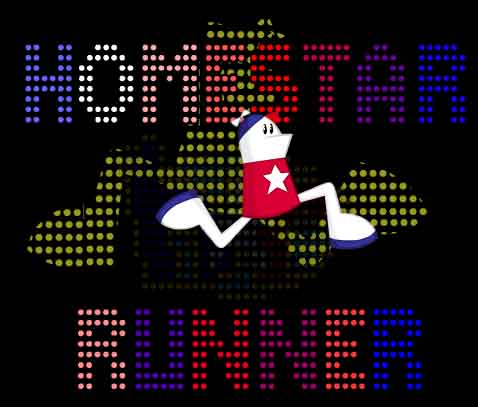 There may be no God in Free Country USA, and the whole sub-universe may be a carefully-woven cocoon to distract from this great absence. The whole thing may be a flash-animated security blanket held onto long after adolescence. But the Brothers Chaps are genuine artists, true to their craft and working without the constraints that would keep them from pursuing their insights in the quirkiest ways. Because of that, even as they strive to stay on the surface and depict characters who are shallow to the core, they manage to walk backwards into the truth, each of their devices of irony bearing indirect witness to the truth it would efface. The crystal-clear recognition of our inevitable obsolescence is something that draws a line of death at the frontier of our existence. The Brothers Chaps are created sub-creators, and you can tell they have at least less outright contempt for their creatures than their own creatures have for their sub-creatures. They have certainly identified the vanity of dispersing yourself across the surface of pop culture with its mediocre entertainments, pastimes so weak that only in the magic of shared memory can they be transfigured into something worthwhile. Taken together, these three things still aren’t much by way of theology, but they are at least pointers, from within the Homestar universe, to something beyond. Something out there for everybody, everybody, Lah-dee-dah-dee-dah!
There may be no God in Free Country USA, and the whole sub-universe may be a carefully-woven cocoon to distract from this great absence. The whole thing may be a flash-animated security blanket held onto long after adolescence. But the Brothers Chaps are genuine artists, true to their craft and working without the constraints that would keep them from pursuing their insights in the quirkiest ways. Because of that, even as they strive to stay on the surface and depict characters who are shallow to the core, they manage to walk backwards into the truth, each of their devices of irony bearing indirect witness to the truth it would efface. The crystal-clear recognition of our inevitable obsolescence is something that draws a line of death at the frontier of our existence. The Brothers Chaps are created sub-creators, and you can tell they have at least less outright contempt for their creatures than their own creatures have for their sub-creatures. They have certainly identified the vanity of dispersing yourself across the surface of pop culture with its mediocre entertainments, pastimes so weak that only in the magic of shared memory can they be transfigured into something worthwhile. Taken together, these three things still aren’t much by way of theology, but they are at least pointers, from within the Homestar universe, to something beyond. Something out there for everybody, everybody, Lah-dee-dah-dee-dah!
“What’s that jarble? Scripture? Are you quoting scripture?” No, coach. Just watching cartoons.